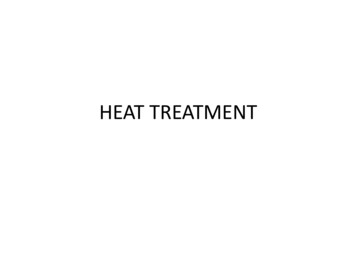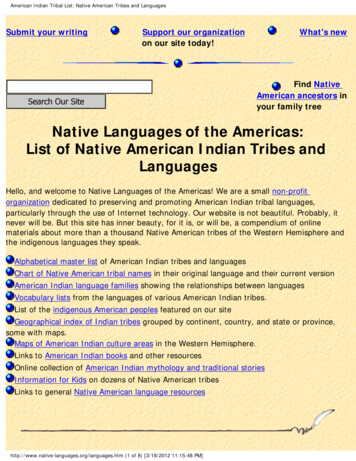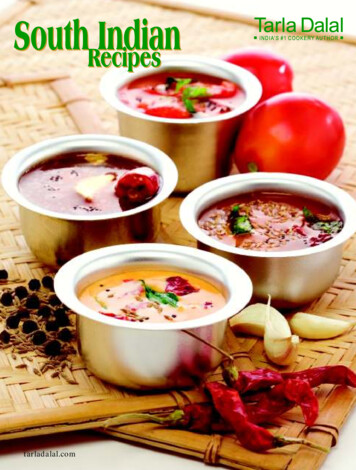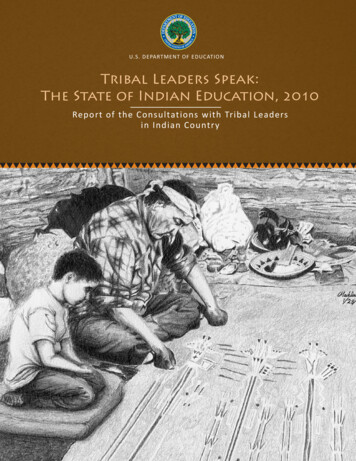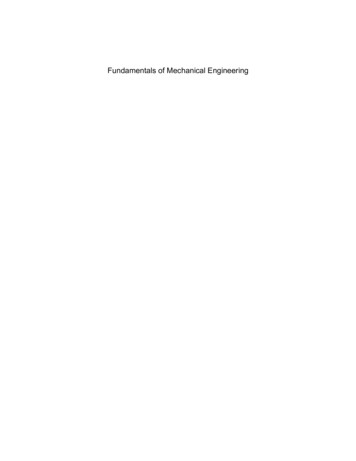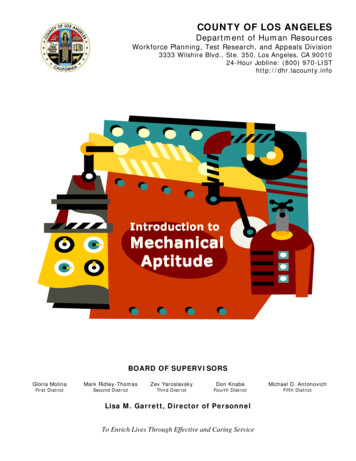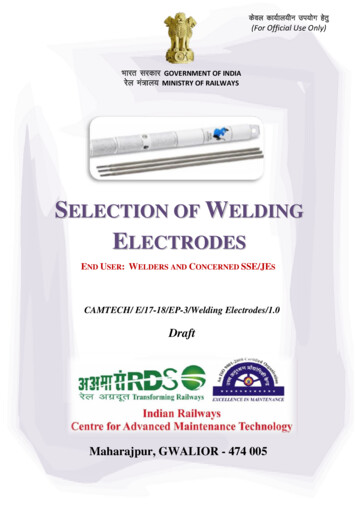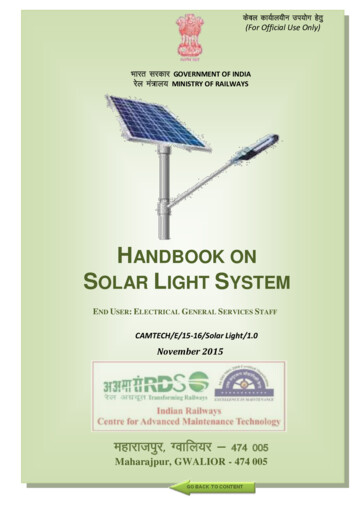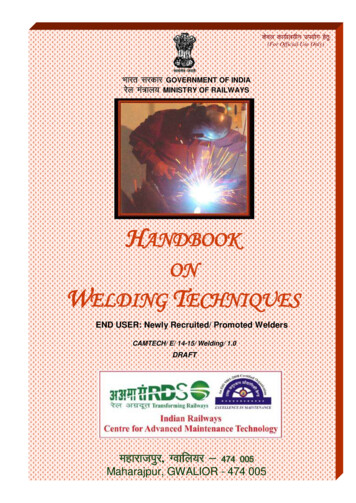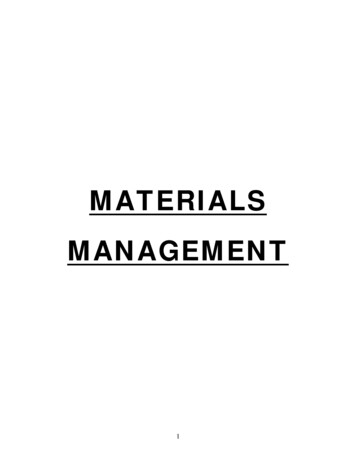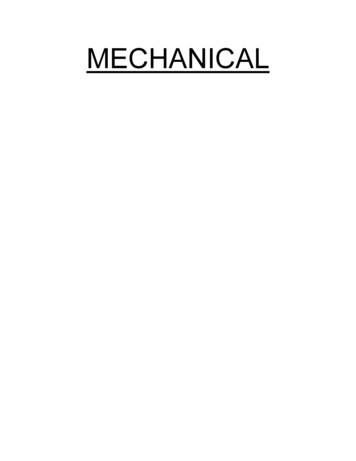
Transcription
MECHANICAL
CONTENTSReading Material For Foundation Course(Mechanical Department)SN. es of Mechanical EngineeringDepartmentClassification of Rolling StockOrganisation of Mechanical EngineeringDepartment in Railway Board, ZonalHeadquarters, Divisions and WorkshopsProduction UnitsTrain DynamicsTraction modes and their ComparisonsDiesel Locomotive – Design features,Major components, Classification andCodification etc.Operation and Maintenance of DieselLocomotivesCoaching Stock- Design and MaintenanceLinen ManagementBio ToiletWagon Stock- Design and MaintenanceImportant Components affecting Safety –Wheel assembly, suspensionarrangement, draw and buffing gears.Brake system on Indian Railways Vacuum brakes and Air brakes.140 Ton Diesel break-down 33-438439-442443-448449-450451-454455-457
Question BankPart ITrue or False type statementsPart IIPart IIIMultiple Choice QuestionsPart IVSubjective questions – short answertypeFill in the blanks type questions458-465466-473473-474745-477
1. Objectives of Mechanical Engineering Department.The main objectives of Mechanical Engineering Department and agenciesresponsible for their fulfillment are summarized below:ObjectivesMaintain and supply dependable systemand diesel locomotives as perpredetermined power plan.Maintain coaches, keeping in view safetyand amenities aspectsAgencyDivisional Organisation &Workshops.Maintain wagons for their safe haulageProduction of locomotives, coaches andwagons as required.Continuous absorption of latesttechnology in the fields of maintenanceand production.Ensuring economic use of fuel-doProduction Units &Private Sector.RDSO & CAMTECHCo-coordinating procurement ofMachinery and Plant for all thedepartments.Periodic overhauling of rolling stockTo maintain Breakdown train in ready touse condition.Linen Management-do-Zonal Headquarters &Divl. OrganisationCOFMOW & Zonal HeadQuartersWorkshopsDivl. OrganisationDivl. Organisation
2. Classification of Rolling StockThe definition of various terms used in rolling stock management are given below:Train - Vehicle /Vehicles moving on rail which need line clear to enter a blocksection.Rolling Stock - Any vehicle capable of moving on railway track excluding pushTrolleys.Locomotives - Engine or motive power source to haul a train. Indian Railwaysuse Steam. Diesel and Electric locomotives.Coaches - Passenger carrying vehicle (PCV) & some non-passenger carryingvehicles (OCV) attached to passenger trains like postal van, luggage van etc.Wagons - Freight rail cars used for transport of freight traffic. Wagon have 4,8 ormore wheels. These wagons may be covered, open, flat , tank or well-type.EMU- (Electrical Multiple Unit)- Self powered set of coaches operated byelectricity.DMU- ( Diesel Multiple Unit)- Self powered set of coaches powered by dieselengine.Rail Cars- Self powered coach generally in single or unit of gRailway Board LevelChairman (Railway Board)Member Mechanical .
Addl. Member (Mech.Engg.)(Stores)Addl. Member (Prod units)Addl. MemberAddl. Member(Mech. Engg.) is responsible for open line working, inter-railwaycoordination and coordination with Addl. Member(Traffic) for rolling stock use.Addl. Member(PU) is responsible for proper functioning of workshops,production units, Mechanical wing of RDSO & COFMOW. He also coordinateswith other directorates for Rolling Stock manufacture and repair.The Addl. Members (General Manager Grade) are assisted by Advisor (HAGrade), Executive Directors (SA grade), Directors (Selection grade), JointDirectors (JA grade), Deputy Directors ( Sr Scale) and Asst. Directors (JuniorScale ).Organization at Zonal Headquarters level.General ManagerCME .CWE& O)CMPE(D)CRSECME(P)CRSE(FCWE ( Chief Workshop Engineer)- is responsible for: Administration of all workshops on the Zonal railway Oversee availability of important items and coordination with Stores Dept. Workshop budget & economy. Maintenance of drawings and specifications of rolling stock itemsCRSE ( Chief Rolling Stock Engineer ) - is responsible for: Proper maintenance of carriage fleet on the open line
Coordination with CWE/ Workshops for availability ofmanufactured items/ sub assemblies. Oversee stock position of vital items and stores coordination Monitor Passenger complaints about amenity fittings.workshopCME(Plg.) ( Chief Mechanical Engineer-Planning) Coordination of M&P sanction and procurement of M&P for all depts. Specification of Machines & Plants and Coordination with COFMOW/COSfor procurement Installation, commissioning, prove out warranty of machines andcoordinate training of personnel for new machines Planning of Works Program required for Mechanical DepartmentCRSE (F&O) (Chief Rolling Stock Engineering- (Frieght &Operations) is responsible for Proper utilization of locos on line. Staff training and conversion training from steam to diesel and electricloco operation. Economic use of fuel Proper maintenance of wagon fleet on open line. Coordination with CWE for availability of workshop manufactured items/sub assemblies.CMPE (D) (Chief Motive Power Engineer Diesel). is responsiblefor Proper maintenance of diesel locomotives. Planning maintenance facilities for diesel locos Liaison with RDSO,DLW, CLW, DMW. Oversee stock of unit exchange spares, particularly imported spares. Monitor outage of diesel locomotivesOrganisation at Divisional levelDRM .Sr. DME/DME(P)SR.DME/DMESR.DME(D)(C&W)
Sr. DME/DME(P) is responsible for maintenance of steam locomotives,maintenance of Break Down trains, Crew management, Running Rooms etc.Sr.DME/DME(D). is responsible for maintenance of diesel locos, monitor dieselloco ineffective and outage position.Sr.DME/DME(C&W) is responsible for proper maintenance of carriage & wagonstock, ineffective percentage, passenger complaints, coach and wagondetachments and other unusual occurrences.Workshop levelWorkshop is headed by CWM/DY.CME/WM/AWM depending upon the size ofthe workshop. Other department Officers in lower grades like Electrical, Stores,Accounts, etc. are placed under his administrative control. Workshop hasfollowing departments.Production Control Organization - Responsible for evaluation, workplanning, material arrangement, work study and implementation of incentivescheme.Inspection - Responsible for quality control in the workshop activities.Repair - Responsible for rolling stock/sub assembly repairs.Manufacture - Responsible for manufacture of components/ sub- assembliesmostly on stores work order.M&P - Responsible for planning, procurement, commissioning and upkeep ofmachine and plant.Establishment -Responsible for payment of wages, promotion and placementof staff and other personal matters.Electrical - Responsible for upkeep of electrical installation, power supply etc.Stores Depot - Responsible for making of the proper material available ,inventory control, scrap disposal etc.
4.Production Units-Indian Railways have following production unitsCLWChittaranjan Locomotive works - Manufactures Electrical Main LineLocomotives - Capacity- 165 locos/yearProduction during 2011-12 – 259Target 2012-13 - 280DLWDiesel Locomotive works, Varanasi - Manufactures DieselLocomotives Capacity- 165 locos/year.Production during 2011-12 – 246Target 2012-13 - 250ICFIntegral Coach Factory, Madras - Manufactures coaches of alltypes - Capacity - 1000 coaches/year.Production during 2011-12 – 1511Target 2012-13 - 1525RWFRail Wheel Factory earlier known as WAP ( Wheel & Axle Plant,Bangalore) - Manufactures Wheel and axles as well as completewheel-sets.Production during 2011-12Target 2012-13Wheels - 201135 Wheel setsWheels – 200000 Wheelsets7031573000Axles99570Axles 95600RCFRail Coach Factory , Kapurthala- Manufactures main-line coaches Capacity - 1000 coaches/year.Production during 2011-12 - 1421Target 2012-13 - 1600DMWDiesel Loco Modernisation Works earlier known as DCW(DieselComponent Works Patiala) – Re-Manufacturing Rebuilding of
Diesel Loco sub assemblies; Repower- packing of Diesel Loco. Ithas now started manufacturing ALCO Diesel loco also.In addition to the above, a Rail Spring Kharkhana Unit is located at Sithauli,Gwalior. This unit (RSK) manufactures springs for Indian Railways requirements.New Production Units: Diesel locomotive manufacturing works – Marhowra/ECR – 2050 Cr. Wheel manufacturing plant – Chapra – 870 Cr. Electric Locomotive Manufacturing Factory – Madhavpura – 1450 Cr. Coach Manufacturing Factory – Rai Bareilly 1500 Cr.
5. Trains DynamicsTrain Resistance - The resistance offered by a train to move from stop is calledStarting Train Resistance. The resistance offered by it to keep it moving at aspecified speed is known as Rolling Train Resistance. In other words forceneeded to start a train from stationary position is starting resistance and forceneeded to keep a train moving at certain speed is rolling resistance.The draw bar pull exerted by locomotive has to be more than the train resistanceto keep a reserve force needed for acceleration. Mathematically startingresistance can be expressed by formula. Rs RVS RG RC RARs Total train resistance at startRVs Vehicle starting resistance -- Depends on bearing design.RG Grade resistance if anyRC Curve resistance if any (On curves, the friction between rail &wheel increases and hence extra force is necessary).RA. Acceleration reserve to be divided depending upon accelerationneed of the train.Rolling Resistance : The resistance during movement is called rollingresistance. It depends on speed and car body design but does not depend onbearing design. Mathematically it can be expressed as RR RVR RG RC RAWhere RR Total rolling resistance RG, RC, R A are same as startingresistance.RVR Train rolling resistance on level straight track.RVR A BV CV2Where A, B & C are constants depending on vehicle design, car bodydesigns. ‘A’ Depends on mechanical friction in bearing. ‘B’ Factorsinclude flange friction, swaying and oscillation characteristics of vehicle.‘C’ Air resistance depends on body design. Aerodynamic design vehicleshave less friction than box type vehicles. The values of A, B, & C aredifferent for different vehicles.
Tractive EffortThe force at rail wheel contact exerted by a locomotive is called Tractive Effort.The tractive efforts at the start get limited by load on driving wheels and limitingfrictional co-efficient between rail and wheel. (adhesion) even though thelocomotive may be capable of producing much more tractive effort at low speedbecause of its horse power. On run, however, it depends on speed, loco horsepower and wheel diameter.Adhesion - It depends on rail wheel friction. Adhesive percentage is defined asratio expressed in percentage of tractive effort at wheel slip and vertical load ondriving wheels.Factors effecting adhesion : - Condition of rail and wheel contact surfacee.g. wet, dry. oily, slippery, etc. - Type of track and sleeper density - Rate ofincrease in torque applied to wheel.Wheel Slip : If torque applied to wheel exceeds the adhesive torque, wheel sliptakes place. This reduces the friction between rail and wheel and further wheelslip takes place. Wheel slip reduce the tractive effort and hence haulage capacityand damages rail and wheel. Wheel slip should ,therefore, be avoided.Method to improve adhesion : - Clean rails regularly - Use sand whilestarting - Immediately cut off power if wheels slip.Equilibrium Speed/Balancing SpeedThe train will go on accelerating till tractive efforts of power is more than rollingresistance. Once TE & TR( train resistance) become equal, the speed cannot befurther increased. This speed is called equilibrium or balancing speed. The lococannot continuously work on full power and hence potential TE should besubstantially higher than TR for better train operation. This also helps in attainingmaximum speed quickly. The balancing speed of a WDM2 loco with a load of4700 ton on level gradient is 59 km/h. So it is desirable to use 2 WDM2 locos inMU for operating such a train.Determination Of Train LoadThe trailing load that can be attached to a locomotive depends upon. Ability of locomotive to start the load on steepest gradient on the section. Attain maximum permissible speed on most of the route Maintain minimum desired speed on steepest gradient. Acceleration level desired.
6.TRACTION MODE AND THEIR COMPARISONSIndian Railways use three traction modes-viz. Steam, Diesel & Electric. Howevermost of steam locomotives have been phased out.Important desired Locomotive characteristics.Load- speed relationshipMaintenance requirement – frequency of maintenance should be less.Riding quality - Disturbances to track should be bare minimum.Reliability- susceptibility to develop defects on run should be low.Maintenance time as ratio of running time should be less.Both side operation - Amenability to both front and back operation .Pollution- impact on environment should be minimum.Foreign dependence- in regard to technology, availability of spares should beminimum.Multiple operation -Amenability for multiple operation.Steam : The steam loco consists of three systems: Boiler to burn the coal and produce heat energy and to use this energy toheat up- water and produce steam at high temperature and pressure. Engine to use steam at high pressure and temperature to producemechanical energy and transmit it to the wheels to produce torque to pullthe train. Tender to store water and coal.The steam engine is very simple in design, easy to maintain and highly reliableequipment. This however, has following drawbacks Needs good quality of coal ( high calorific value and low ash contents), ascarce commodity in India Low load hauling capacity High pollution Fire hazard Needs frequent stoppages for watering/ filling up coal.
Low Utilization (Kms/day)Diesel Locomotive - This loco also consists of three major systems Diesel Engine - to convert chemical energy of diesel oil into mechanicalenergy Transmission - to transmit the energy produced by diesel engine toobtain rotation of the wheels Control - to control production of energy/ transmission affection.Electric Locomotive - This also has three main system. Pantograph to collect electric energy from overhead wire. Transformer/ Rectifiers to step down the voltage and convert into DC. Control Circuit to control power into loco wheels.Comparison of Steam, Diesel & Electric locoCriteriaSteamDieselElectricLoad/ SpeedLow LoadHigh Load (Veryhigh with MU)High Load (Veryhigh with MU)Low SpeedHigh SpeedHigh SpeedNeed forstoppages forloco requirement.High - Every150 KmsLow - Every 3000kmsVery LowRiding rseOnly forward.Both denceNilRegular( for HSD oil )Minimum
OperationalflexibilityHighHighRestricted (OHEneeded)Running costHighLow.LowCapital costLowHighHigher7.Diesel LocomotiveDesign FeaturesA steam locomotive engine is directly coupled to the wheels. This is so becausesteam engine is capable of producing adequate torque at starting and at very lowspeeds.The diesel engine, however , cannot produce high power at start or at very lowengine speeds. It is, therefore, necessary that engine is decoupled from wheelwhile starting and till it attains a minimum working speed. This is achieved byclutch and gear box in automobiles. The clutch gearbox combination is termedas transmission. Transmission is necessary for all IC engines.
In automobile engine, the clutch provides to decouple the engine from wheel, andgearbox helps to increase/ decrease mechanical torque as per requirement ofspeed/torque. The horse power of automobile engines are low and hencemechanical clutch with mechanical gear box are quite suited for transmission.The engine power is very high for rail locomotive engine. Mechanicaltransmission is, therefore, not suitable as it becomes very bulky and difficulty tooperate. The transmission of diesel locomotives is therefore either hydraulic orelectrical.In hydraulic transmission, hydraulic coupling with reversing gear box is used.Hydraulic torque converter acts as clutch and gearbox combined into one withinfinite gear ratios. The output torque can be varied from infinitely from zero tomore than engine torque. One side of torque converter (impeller end) isconnected to engine and continuously rotates while other side (turbine end) isconnected to wheel by suitable gear train. The hydraulic transmission attainspeak efficiency at a specific speed, and falls steeply on either side of it. By multistaging the converter, high efficiency can be maintained in the entire workingrange.On most of our mainline diesel locos, IR have gone in for electrictransmission. In this type of transmission, the engine is permanentlycoupled to a DC Generator. The output of the generator is fed to tractionmotors through a control circuit which varies the torque- speedrelationship. The traction motors are directly mounted on the axles anddrive the axles through gears.Various types of TransmissionsTRANSMISSIONMECHANICAL TRANSMISSIONLimitation – HP transfer up to 170DieselEngineGearBoxClutchWheelHYDRAULIC TRANSMISSIONLimitation – HP transfer is unto 1400DieselEngineELECTRIC TRANSMISSIONDieselEngineTurbinePumpDC GENERATOROrAC AlternatorOilTraction Motors1. DC2. ACWheel43
Some of the major components are : Engine or power pack to produce power for transmission. Governor to regulate fuel input according to Generator demand and tomaintain constant engine RPM at each notch. Throttle - to vary engine RPM and power out put Traction Generator - to convert mech. energy into electric energy. Expressor - to produce compressed air for locomotive braking and tooperate various contractors in the control circuit, and vacuum for the trainbrake system. Radiator Fan - to cool engine cooling water Traction Motor - to convert electric energy to mechanical energy (fordriving the wheels) Turbo Super Charger - to compress air before input into engine forcombustionDIESEL LOCOMOTIVE-LAYOUTLong HoodHoodBogieCabinMain ReservoirFuel TankLOCATION OF ASSEMBLIESShort
Radiator Fan Turbo mpressorStandCentre PivotTractionAux. GeneratorBogie FrameSide BearerControlTractionMotorRoller Bearing BoxEqualising BeamHelical Springs
Some of the Safety Components are:Over Speed trip mechanism – it trips the power if engine RPM exceeds thepredetermined limit.Wheel slip relay – it reduces the power to traction motor if wheel slip takesplace.Hot engine alarm – it gives alarm if cooling water temperature exceeds thepredetermined limit and cuts off the power if engine remains hot for a specifictime.Sand gear – to sprinkle sand on the rail to improve adhesion.Classification and Codification of diesel locos.Diesel loco are classified on wheel arrangement by 2-4 letter codes.BBi- axle bogie with mechanical coupled axlesCTri- axle bogie with mechanical coupled axlesBOBi-axle bogie with independently driven axlesCOTri-axle bogie with independently driven axlesDiesel locos are coded to indicate gauge, traction mode, end use and modelnumber. This is four letter code.1st letter : Gauge (W-BG,Y-MG,Z-NG(2’6’) and N-NG(2’)2nd letter : Traction Mode (D-Dsl, A-AC,C-DC)3rd letter : Service (P- Pass, G- Goods, S-Shunting, M-Mixed )4th letter : Suffix number; Design/ Model no.e.g. WDM2 – A broad Gauge Diesel Locomotive suitable for mixed services i.e.,both passenger & goods train operation.Classification, code & wheel arrangement of IR diesel locos are shown intable below :LocomotiveCodeClassification HorsePowerTransmission
WDM 2WDM3AWDG3AWDP3AWDP1WDG4WDP4WDP4DWDG4DWDG5WDS 4WDS 4A or BWDS 5CO- COCO- COCO - COCO - COBO-BOCO-COA-A-1, 1-A-ACO-COCO-COCO-COO-C-OO-C-OCO - h (Suri)Hydraulic/Hydro-mechElectricWDS 6YDM 4ZDM 5CO - COCO COB1 - B114001400490ElectricElectricHydraulicCost of Diesel LocosWDG3A – 9 crores ,(Indicative Price)WDG4 – 12.5 crores ,WDM2 - Rs. 4.5 croresCodal life of Diesel Locos : 36 Years ( with a Re-powerpacking after 18 years,Viz. Mid-life rehabilitation/ Rebuilding done at DMW/Patiala)8.Operation & Maintenance Of Diesel LocoHaulage capacity of a WDM2 LocomotiveStarting Tractive Effort 30.4 tonnesContinuous Rated Tractive Effort 24.6 tonnesIt can haul a train of 4700 tonnes on level track with a balancing speed of 59kmph.Fuel & Lubricating Oil Consumption Targets- The bulk of main lineB.G. diesel Locos on Indian Railways are WDM2 Locos. The fuel consumption ofa WDM2 loco under idle conditions is 20-25 lit/ hrs, but at 8th notch fuelconsumption is about 450 litres / hr. But specific fuel consumption on IR isgenerally measured in terms of litres/ 1000 Gross Ton Km which depends uponload, average speed, grade & curvature of section etc.
The target for level section is 2.5 lit/ 1000 GTKM for goods operation & 4 lit/ 1000GTKM passenger for Passenger operation.Lubricating oil consumption is generally measured in terms of percentage of fueloil consumption and its target is less than 1.5% of Diesel Oil.Diesel Loco MaintenanceWhen steam locomotives were introduced, India was lagging in engineeringindustries and hence the concept of having Railway Workshops was created.The stress was on repair of sub-assemblies rather than replacement anddiscarding of old components. This concept has undergone a revision for dieselloco maintenance. Most of the items are purchased from trade and the worn-outparts are replaced rather than repaired. This has emerged due to the nature ofparts, viz. rubber fittings, gaskets ,filters, electrical contactors, precisionmachined valves, etc. Even for major assemblies, the concept is to change thecomplete assembly in shed rather than repair in position. The assembly is thensent to the particular section for overhauling and testing. For this purpose, a poolof important sub- assemblies (unit exchange spares) is kept in each dieselshed/shops for this purpose.Diesel locos are allotted a specific homing shed, which is responsible to maintainit properly. Suitable preventive maintenance schedules, specifying part to bechecked , repaired and replaced are specified to ensure trouble free service online.Various locomotive maintenance schedules, the periodicity and time required forundertaking them is given below :SchedulePeriodicityPlaceTrip20/30/40 days*Any shedM44 monthsHome ShedM88 monthsHome ShedM1212 MonthsHome ShedM2424 monthsHome shedM4848 monthsHome ShedPOH8 yearsWorkshop
Rebuilding18 yearsDMW* As per RB letter 2003/ M(L)/466 dated 27.6.08,Loco with pure air brake,microprocessor control system and roller suspension bearing. Loco should bekept under monitoring. Also as per RDSO letter no.SD.WDM.2.9 dated24/27.05.13After 18 years, locomotive is sent to DMW/ Patiala for rebuilding/remanufacturing.Diesel shed records- Important records maintained by diesel sheds are:Daily position sheet - gives details of loco outage, dead locos on lines, locosundergoing schedules, locos expected to go out and come into shedRepeated Booking RegisterWheel profile registerHistory of Repairs carried out - LocowiseLoad test results.Diesel oil Consumption /Specific fuel consumption RegisterLub oil consumption Register.AvailabilityA Rolling stock is said to be ‘ineffective’ if it is not available for the whole day i.e.from O hrs to 24 hrs. The present target for ineffectiveness of WDM2 locos is10% (earlier it was 12.5%). However, its outage (availability for train operations)is also watched on 4- hourly basis for which a further allowance of 10% is givenfor running repairs. So, the sheds are required to maintain on 4- hourly basis anoutage of 81% of Diesel Locos for Train operations. However for PassengerLocos the outage is to be maintained as per Locos Links.Target Outage calculationTotal holding of diesel shed ------ X10% allowance for heavy repair----10% of X 0.1XAvailable for traffic X-0.1X 0.9X
Passenger link say YAvailable for freight operation 0.9X-YRunning repair 10% 0.1(0.9X-Y)Net target freight outage (1-0.1)(0.9X-Y)Multiple Unit OperationThe Diesel-electric locos are capable of being coupled together to work inMultiple Unit Operation in which only Leading Loco is required to be manned ,whereas all the trailing locos are controlled by Leading Loco to run at the samenotch and produce power accordingly. In case of multiple loco operation trailinglocomotive can be notched up or down from the same controls available with thedriver of leading locomotive. Similarly Brake application on trailing locomotive willbe as per brake aspects on the leading locomotive.GM/EMD Locomotives:Indian Railways have purchased the following:1.2.3.4.13 assembled WDG 4 locomotives9 partly knocked down WDG 4 locomotives.10 assembled WDP 4 locomotives.Technology for manufacturing of these locomotives at DLW/Varanasifrom M/s General Motors, USA.DLW has started manufacturing this loco,
Features of GM/EMD Locomotives:1.2.3.4.5.6.7.8.9.10.4000 HP locomotive equipped with 16-710 G 3B engine.540KN starting Tractive Effort.270 KN Braking Effort.4% improvement in fuel efficiency.AC-AC technology.Micro processor based traction control.Electronic brake system.High adhesion and high speed bogie.90 days trip schedule.Bogie overhauling after 1.6 Million kms.COMPUTERSGM locomotive is provided with 3 computers:1.2.3.Main computer named as EM 2000 which –a. Does total control over diesel engine performance including safetyaspects.b. Does trouble shooting and self diagnosis.c. Alpha numeric display.d. Archive memory and data logging.Siemens computers which controls converters.Knorr computer.Comparative Performance of WDM2 and WDG4 (GM) is as under:S.No.Indices1Weight of train that can be hauled 4500on level track (Tons)Weight of train that can be hauled 3085on 1:200 gradientBalancing speed with 4700 ton5923WDM2WDG4 (GM)9400%Gain1095455778544
456789101112trailing loadAvailability (Locos on line/locosowned)Trip ScheduleShop attentionReliabilility (Track KMs)Lube Oil consumption (% of Fueloil consumption)SFC (gms/ bhp/hr)HP OutputStarting adhesionStarting Tractive effort81% 90%20 to 30days8 years1 lacs1.590 days16 years4 lacs0.516730066164.24260027%30.4 T151400042%52T95455%74TECHNOLOGY PROGRESSION:Remote Monitoring and Management of Locomotives:12
With the help of remote monitoring (ALCO) following are the advantages:1.2.3.On line health monitoring and fault diagnostic of locomotives ispossible.Conditional maintenance of locomotive can be done resulting inincreased periodicity of shed recall power.Feasibility of advanced train control is possible.Introduction of IGBT Traction Control Converter: EMD Locomotive1.2.3.Traction Control Converter, the heart of AC-AC traction system, isbasically a computer controlled inverter. High voltage GTO is used inexisting TCC as main switching device. IGBT has been recentlyintroduced in these applications because of better efficiency,characteristics and reliability.Indian Railways Diesel Traction has timely adopted this newtechnology and manufactured first locomotive equipped with IGBTbased converter in Nov ’06.After successful field trials, IGBT has been introduced in serieslocomotive production from Sept ’07 onwards.4500 HP Power Upgradation:1.2.3.4.1st 4500 hp loco (12114) with EMD IBT was commissioned in field inMay ‘2007.Two more locomotives equipped with IGBT were commissionedsubsequently.Series production of 4500 hp EMD locomotives has started.Existing fleet with GTO TCC is also being planned to be upgraded to4500 hp.Operational advantages:LoadFreight operationCoaching58 BOXN18 Non AC 6Balancing speed (KMPH)4000 HP4500 HP8592123130Improvements in EMD Passenger Locomotives:Introduction of EMD IGBT has lead to new series of EMD passenger versionnamed WDP4B with 4500 HP and 6 TMs configuration.WDP4B will have maximumspeed potential of 130 kmph.
3.Hotel Load:Hotel load module of 500 kVA capacity, 750 Volts, 3 phase for BOG rake is beingdeveloped.Benefits:1. Significantly higher efficiency.2. Reduced tare weight of train. Additional Passenger capacity will begenerated by replacement of power cars.Two WDP4 locomotives with hotel load have been turned out in 2010and trials are on.Further improvements planned in EMD locomotives are as under:1.Electronic Fuel Injection Systema. Fuel saving upto 2%b. Engine emission Tier – 2 complaint.2.Enabling Distributed Power Operation: Following are the advantages:a. Long haul operation of freight trains.b. Train set operation for passenger trains.c. Support 200 Car trains or longer.d. Allow increased average speed, reduced cycle times.e. Reduce coupler forces.f. Push pull train operation.g. Reduce energy consumption, derailment risks, wheel wear.h. Improve safety based upon reduced stopping distance.
9.Coaching Stock - Design And MaintenanceThe standard coach which was developed after first World War was a woodencoach on steel under frame (4-wheeled). Later bogie coaches with wooden bodyand steel under frame were developed (IRS coach). Further developments havesince taken place to provide more built-in strength and to make the coach lighter.Now ICF anti-telescopic integral coach with all coil spring bogies have beenmade a standard design for Indian Railways which has a better riding qualitycompared to IRS design coach.ICF COACHShellBogieICF Coaches - IRS coaches were heavy and used to suffer extensive damagein collision / accident resulting in heavy passenger casualties. Integral designwas developed in
RWF Rail Wheel Factory earlier known as WAP ( Wheel & Axle Plant, Bangalore) - Manufactures Wheel and axles as well as complete wheel-sets. Production during 2011-12 Target 2012-13 Wheels - 201135 Wheel sets Wheels - 200000 Wheel sets 70315 73000 .
